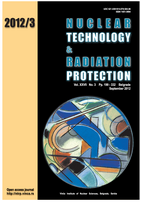
THERMAL-HYDRAULIC BEHAVIOR OF PHYSICAL QUANTITIES AT CRITICAL VELOCITIES IN A NUCLEAR RESEARCH REACTOR CORE CHANNEL USING PLATE TYPE FUEL

Vol.
XXVII, No. 3, Pp. 199-332
September 2012
UDC 621.039+614.876:504.06
ISSN 1451-3994
Pages: 229-238
Authors: Kamel Sidi Ali, Zaki Boudali, and Rachid Salhi
Abstract
The thermal-hydraulic study presented here relates to a channel of a nuclear reactor core. This channel is defined as being the space between two fuel plates where a coolant fluid flows. The flow velocity of this coolant should not generate vibrations in fuel plates. The aim of this study is to know the distribution of the temperature in the fuel plates, in the cladding and in the coolant fluid at the critical velocities of Miller, of Wambsganss, and of Cekirge and Ural. The velocity expressions given by these authors are function of the geometry of the fuel plate, the mechanical characteristics of the fuel plate's material and the thermal characteristics of the coolant fluid. The thermal-hydraulic study is made under steady-state; the equation set-up of the thermal problem is made according to El Wakil and to Delhaye. Once the equation set-up is validated, the three critical velocities are calculated and then used in the calculations of the different temperature profiles. The average heat flux and the critical heat flux are evaluated for each critical velocity and their ratio reported. The recommended critical velocity to be used in nuclear channel calculations is that of Wambsganss. The mathematical model used is more precise and all the physical quantities, when using this critical velocity, stay in safe margins.
Key words: nuclear reactor, reactor core, reactor channel, fuel plate, critical velocity, heat flux
FULL PAPER IN PDF FORMAT (713 KB)